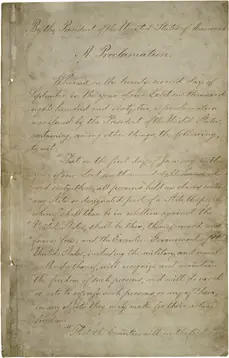The Emancipation Proclamation was an executive order passed on January 1, 1863, freeing all slaves in Confederate states that had seceded from the Union and allowing them to join the Union army.
Why Did Abraham Lincoln Sign the Emancipation Proclamation?
The proclamation was a military measure designed to weaken the Confederate army and raise morale in the Union. Abraham Lincoln hoped these freed slaves would abandon the plantations they worked on, which would further weaken the southern economy, and join the Union army.

Copy of the Emancipation Proclamation
The proclamation only affected a small number of slaves because it only applied to areas of 10 seceded states not already under Union control. These states included Arkansas, Texas, Louisiana, Mississippi, Alabama, Florida, Georgia, South Carolina, North Carolina and Virginia.
The proclamation did have some limitations, according to the National Archives website:
“Despite that expansive wording, the Emancipation Proclamation was limited in many ways. It applied only to states that had seceded from the Union, leaving slavery untouched in the loyal border states. It also expressly exempted parts of the Confederacy that had already come under Northern control. Most important, the freedom it promised depended upon Union military victory.”
Why Did the Emancipation Proclamation Only Free Slaves in Confederate-Occupied Areas:
Lincoln was aware that freeing the slaves in some states while keeping slaves in other states in chains went against this general idea of freedom but he feared freeing slaves in Confederate states that were still loyal to the Union would anger these states and prompt them to secede as well.
Feeling that he needed a major military victory to win support for the proclamation, Lincoln waited to announce the proclamation until after the Union army won the Battle of Antietam in September of 1862. When Colonel Robert E. Lee and the Confederate army retreated from Antietam, Maryland after a devastating defeat, Lincoln decided it was time and announced the forthcoming proclamation a few days later.
The preliminary Emancipation Proclamation was issued on September 22, 1863 and stipulated that if the Southern states did not cease their rebellion by January 1st, 1863, then Proclamation would go into effect.
What Effect Did the Emancipation Proclamation Have?
Some sources argue that the Emancipation Proclamation did not actually free a single slave, since the slaves it referred to were in Confederate controlled areas where Lincoln’s authority was not recognized.
The order may not have freed these slaves under Confederate rule but it did free them under federal rule and, thus, gave them an opportunity to escape their bondage, as Henry Louis Gates, Jr., explained in an article, titled Did Lincoln Really Free the Slaves?, on the website TheRoot.com:
“The Emancipation Proclamation, despite its enormous symbolic significance, did not abolish the institution of slavery in the United States. Rather, it ‘freed’ any slave in the Confederate states (that’s right—it did not apply to states in the Union in which slavery remained legal) who could manage to flee her or his plantation and make their way behind liberating Union lines. Historians estimate that as many as 500,000 black people managed to do this. So we might say that these black people freed themselves.”
What the Emancipation Proclamation mostly did was change the reasoning behind the war. Although slavery was one of many causes of the Civil War, ending slavery was not the original objective of the war. Preserving the Union and preventing Confederate states from seceding was the main goal of the Civil War.
When lawmakers passed the proclamation, it changed everything. Suddenly, the war became a fight for justice and winning it meant freedom for thousands of slaves. This not only raised morale in the Union and strengthened the army, but it also prevented England and France (two anti-slavery countries) from giving military aid to the south.
In addition, the proclamation also allowed for the acceptance of black men into the Union army and navy.
Ultimately, the Emancipation Proclamation paved the way for the 13th amendment which freed all slaves in the United States and abolished slavery forever.
Sources:
The Root; Did Lincoln Really Free the Slaves; Henry Louis Gates Jr: theroot.com/did-lincoln-really-free-the-slaves-1790874318
Our Documents: Emancipation Proclamation: www.ourdocuments.gov/doc.php?flash=true&doc=34
PBS: Emancipation Proclamation: www.pbs.org/wgbh/aia/part4/4h1549.html
National Archives: Emancipation Proclamation: www.archives.gov/exhibits/featured_documents/emancipation_proclamation/

